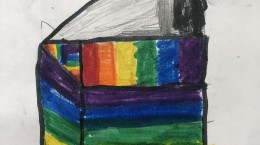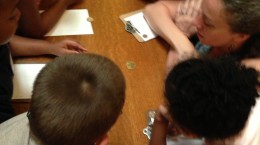Subscribe to Blog via Email
Recent Posts
Recent Comments
- Dante Ventresca (RSS) (110)
- Rebecca King (RSS) (35)
- Brad King (RSS) (18)
Authors
Chairs
“We put red chairs down on Monument Circle.” This was the sentence that came out of my mouth during a business meeting with a client yesterday. He had just asked me about TOI’s current projects. “What?” I repeated the sentence, “We put red chairs down on Monument Circle”. At this point it became clear to me that we were going to talk about the chairs.
He asked a series of questions, one following the other, without stopping: Why chairs? (they are inviting and comfortable) How many? (40) Red? (red and tan) Really? (really) Where did the idea come from? (observation, dialogue, research, experience… in other words paying attention) Will it happen again? (?)
Half way through our discussion it occurred to me that, for this moment, there were two kinds of people in the world. There were the people that interacted with the chairs down on the Circle on Tuesday. And, there were those, for incalculable reasons, who didn’t have a chance to see how 40 chairs completely altered the vibe of the Circle for a few hours.
If you had been there you would have seen friends drawing the chairs up into tight circles and chatting during their lunch. You would have seen the man dribbing a basket ball, a bicyclist resting in the sun, two lovers sitting side by side in two chairs over in the shade. You would have seen the family on vacation putting their feet up. There were the foreign exchange students taking turns posing in a chair with cell phone cameras snapping. There was the woman making a video, a conversation about landmarks in Indiana, someone whispering about art.
As one of the two artists who concieved, designed, and installed this creative gesture of Indy hospitality I found myself absorbed into something bigger than the chairs. I realized that this “something” had been at work before the chairs were set up and remained in effect after we took them down. The chairs simply made it easier to see: We absolutely love being around other people. Cities exist because we are social beings. We gather for a lot of reasons. Most of these are so absorbed into our daily patterns of behavior that many of us no longer remember why there are “downtowns” all over the world and what makes our downtown Indy unique?
But I’m pretty sure that for a few hours on Tuesday, downtown on Monument Circle, for those of us who happened upon those chairs, we were looking directly at the handprint of Indianapolis. The identifier of Indy is in its people, doing what people do all over the world, except that it is happening here – Indystyle.
I’ve found places to sit from Venice, to New York, to Manila. And whenever I sat down in those places I wanted to see the people around me living their lives, getting on with the business of their days, moving toward all their unknowable destinations. I’d like to think that I’m not alone in embracing the mystery of a place. I’d like to think that each of of us is at work compiling evidence of ordinary and remarkable moments.
This is some of what was discussed during the pop up conversation that interrupted our business meeting yesterday. We both knew that we had to get back to work but we decided to hold off for just a couple of more minutes. The client mentioned that because of the conversation he felt as if we were talking as friends rather than business associates. So I found the chairs, the story of the chairs, working beyond the confines of the event on the Circle. And, I noticed that somehow, without warning, both of us had given ourselves permission to hesitate before entering back into the stream of our business. This is what I saw happening with the chairs. People hesitated, dragged the moment out a little bit longer, gave themselves a chance to take in the beautiful day.
Rebecca and I often refer to design imperatives – a cluster of collaborative values that give rise to concrete ideas. The chairs came out of our discussions of community and legacy. Near the core of this Indy Loves You event is what I refer to as “the third chair”. This is Thoreau writing from Walden in the 1840s: “I had three chairs in my house; one for solitude, two for friendship, three for society. When visitors came in larger and unexpected numbers there was but the third chair for them all, but they generally economized the room by standing up. It is surprising how many great men and women a small house will contain.”



